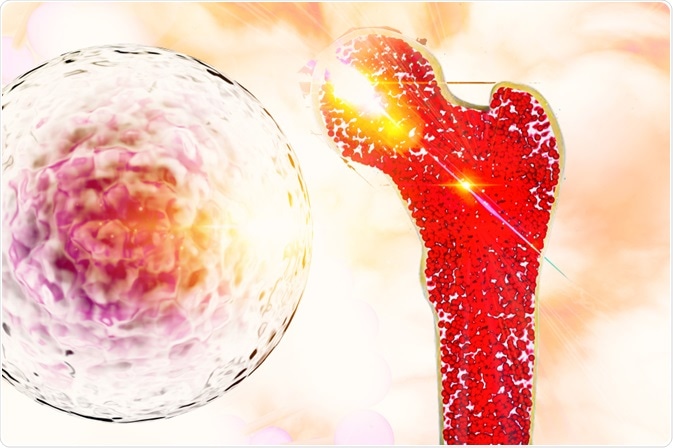Over the past decades, stem cells are being broadly used as regenerative medicine for repairing or replacing tissues that are damaged due to injury or diseases. With the advancement in stem cell therapy, scientists have now engineered stem cells that can effectively treat metastatic bone cancer without damaging surrounding normal tissues.

Image Credit: Kateryna Kon/Shutterstock.com
What are stem cells?
Stem cells are unspecialized cells with two distinct characteristics: unlimited self-renewal capacity; and the ability to differentiate into many types of tissue or organ-specific specialized cells.
So far, three types of stem cells have been identified. These include embryonic stem cells (derived from embryos); adult stem cells or somatic stem cells (derived from adult tissues); and induced pluripotent stem cells (genetic reprogramming of normal adult cells to induce embryonic stem cell-like properties).
How stem cells are utilized in medical science?
Human stem cells are most commonly used in cell-based therapies, wherein stem cells are allowed to differentiate into specialized cells that can be used for tissue repair purposes. In patients with bone marrow injuries or damaged immune system, stem cells derived from bone marrow or blood can be transplanted to restore normal bone marrow functions.
This is called stem cell transplantation. This technique is widely used to treat bone cancer patients who suffer from chemotherapy-induced bone marrow damage or suppressed immunity.
In cancer patients, the functions of T cells, which play a key role in adaptive immunity, are altered in a way that facilitates cancer cells to escape T cell-mediated elimination. The generation of T cells from induced pluripotent stem cells that can specifically recognize and destroy cancer cells is another potential stem cell therapy to improve cancer-related prognosis.
Cancer stem cells play a crucial role in the onset and progression of cancer. The key steps in immune system-mediated cancer eradication include activation of cancer cell-specific T cells by antigen-presenting cells (dendritic cells, B cells, and macrophages); recognition of cancer stem cell-specific surface antigens by the activated T cells; and subsequent destruction of cancer stem cells.
In cancer vaccination, dendritic cells derived from stem cells can be loaded with cancer stem cell-specific surface antigens and infused into cancer patients to trigger an immune response that destroys cancer cells.
In cancer-related gene therapy, stem cells are used as a medium to carry and deliver therapeutic drugs or viral vectors specifically to tumor sites. The unique property of stem cells to migrate toward the site of injury is utilized in stem cell-based gene therapy. In particular, bone marrow mesenchymal stem cells are best suited for delivering therapeutics to tumor sites.
The cytokines secreted by tumors facilitate the migration process by stimulating mesenchymal stem cells to produce more chemokines, which are small cytokines responsible for directed cell migration.
How stem cells are utilized for bone cancer treatment?
Stem cells have been widely used for the treatment of bone cancers. For example, mesenchymal stem cell transplantation has become an attractive strategy to treat patients with bone disorders, including bone cancer.
Mechanistically, mesenchymal stem cells are induced to differentiate into osteoblasts, which in turn form the bone matrix on hydroxyapatite ceramics. Such implants are used to reconstruct the bone parts that are excised during the removal of bone tumors through limb salvage surgery.
Pathological destruction of the bone (osteolysis) is potent comorbidity of metastatic bone cancers. In the bone, metastatic cancer cells induce osteoclastogenesis, resulting in increased formation of osteoclasts. These cells are responsible for bone resorption characterized by increased bone tissue breakdown and release of bone minerals.
Therefore, stem cell-based targeted delivery of drugs that can inhibit osteoclastogenesis has become an important strategy to manage metastatic bone cancers.
Recently, a study has been carried out to develop mesenchymal stem cells that can concurrently express a combination of drugs for targeting both bone cancer and its microenvironment. Using the mRNA-based protein expression method, mesenchymal stem cells have been loaded with three distinct therapeutic drugs: one for specific homing of stem cells to the metastatic site; one for efficient destruction of cancer cells; and one which is a cytokine receptor for inhibiting osteoclastogenesis.
These engineered mesenchymal stem cells have been found to efficiently and specifically target the metastatic bone cancer probably due to increased interaction of P-selectin glycoprotein ligand-1/Sialyl-Lewis X with P-selectin, which is expressed on the blood vessels surrounding the tumor. Also, the stem cells have been found to effectively destroy the cancer cells without affecting bone integrity.

Image Credit: CI Photos/Shutterstock.com
What are the benefits of engineered stem cells?
The common therapeutic modules for bone cancer, such as surgery, chemotherapy, and radiotherapy, are mostly associated with adverse side-effects. Similarly, drugs that are used to prevent bone cancer-related comorbidities (osteolysis) do not generally have effective anti-tumor properties.
In cell-based targeted therapies, genetically modified cells are used to deliver only a single type of drug, which is not a very safe technique.
In contrast, mRNA-based engineering of mesenchymal stem cells comes with many advantages. For example, it is an easy and safe method as no genetic engineering is needed. This process allows the rapid and transient expression of multiple proteins at a time that can facilitate targeted cancer cell death with minimal side-effects.
Further Reading
Last Updated: Oct 29, 2020